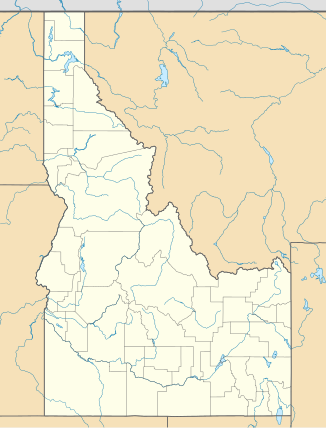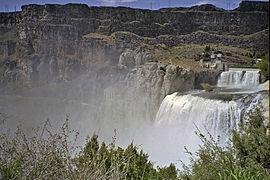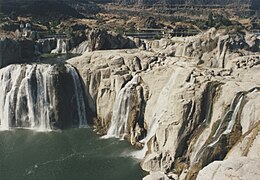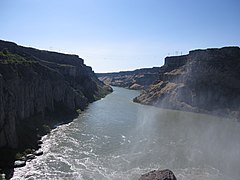Shoshone Falls
| Shoshone Falls | ||
|---|---|---|
|
Shoshone Falls 2018 |
||
| Coordinates | 42 ° 35 '43 " N , 114 ° 24' 3" W | |
|
|
||
| place | Twin Falls , Idaho , USA | |
| height | Falling edge : 65 m | |
| width | 300 m | |
| Number of fall levels | 1 | |
| Mean flow rate (MQ) | 101.3 m³ / s | |
| Falling watercourse | Snake River | |
| Estuarine waters | Snake River | |
The Shoshone Falls are among the largest waterfalls in the northwestern United States . They are located on the Snake River , which has its source in Yellowstone National Park and flows through Wyoming to Idaho . About 3 mi (4.8 km ) east of the village of Twin Falls , the water rushes over a nearly 300 m wide ledge about 65 m below the ground. Sometimes the falls are also referred to as "Niagara of the West" ( Niagara Falls of the West). They are about 14 m higher than this.
History and ecology
The Shoshone Falls were formed around 14,000 years ago in the last Ice Age, when the water masses of Lake Bonneville broke through the lakeshore in the north, poured into the plain of the Snake River in a catastrophic tidal wave and deep gorges formed. Due to their height they form an insurmountable obstacle for fish on their migration to the spawning grounds. Below the falls you can find sturgeon, salmon or rainbow trout. Above is a species of freshwater trout called the Yellowstone Cutthroat Trout . Because of these significant differences, the World Wide Fund for Nature has classified the Shoshone Falls, the boundary between the upper Snake River and the unglaciated Columbia River, as a freshwater ecoregion. Before the numerous dams were built below the falls, there were large stocks of salmon in the Snake River. Salmon fishing at the bottom of the falls was the primary food source for Bannock and Shoshone Indians. An expedition from 1843 claimed that they ran into the water with their spears in the spring and could easily catch a salmon with a targeted throw or push.
Today there is a park right next to the waterfalls with bathing facilities above the waterfalls and a small information board about the history of the discovery and the first use by the immigrants. The site was bequeathed to the City of Twin Falls by Frederik J. Adams and Martha Stone Adams on condition that it be preserved as a public park. Spring is the best time to visit the falls when the snow melts. During the summer, some of the water is used for irrigation, so the amount of water is reduced. In autumn, the water flow is minimal, so the Shoshone Falls appear almost dried out. At the time, the water from the Snake River is used to replenish the water reservoir located upstream.
Only 35% of the fish species in the Upper Snake River are identical to those in the Lower and Columbia Rivers. Fourteen of the species found in the upper reaches are also found in the Bonville freshwater ecosystem (which extends to Utah in the Great Basin ), but not in the lower reaches or the Columbia River. In addition, there are endemic mollusks (such as water snails and mussels) in the upper section of the river , which suggests a high water quality.
The waterfalls were named in 1905 to honor the memory of the Shoshonen , a tribe of indigenous people who once populated this area.
Hydroelectric power plant
As early as 1906, a hydroelectric power station was built at Shoshone Falls, which first generated energy in 1907. It was part of the Greater Shoshone and Twin Falls Water Power Company. New units were put into operation in 1909, 1921 and 1936. In 1916 ownership of this project passed to Idaho Power.
Electricity generation capacity
The project has a capacity of 12,500 kilowatts. It is a flow system, which means that the incoming water flows out again at the bottom because the water is not stored in a reservoir. The turbines are to be renewed by 2015.
Gold discovery on the Snake River
In the fall of 1869, gold was first discovered below Shoshone Falls. This led to a brief but significant gold rush that drew up to 400 English gold miners to the canyon. Several mining camps have sprung up on the banks of the Snake River. In the late summer of 1870, Chinese gold diggers came for the first time to assert their own claims. However, they suffered significant hostility from the English-born miners, and a local ban on Chinese immigrants was passed. After just one year, most of the gold deposits were already exhausted, so the miners withdrew and the ban was lifted. The Chinese prospectors stayed and continued the search. Some of the Chinese lived in the Springtown mining settlement, while others lived in small huts near their claims. An estimated 500 Chinese lived there in the mid-1870s. After all deposits were exhausted in 1879, however, these also left the area. An 1880 census showed that there were only 22 Chinese in Cassia County , which at that time comprised all of today's Twin Falls County .
Evel Knievel
Evel Knievel tried to jump the Snake River near Shoshone Falls in the heyday of his daring motorcycle attraction phase. Neither the depth of the gorge (500 m) nor its width (400 m) deterred him when he tried to fly over the gorge on his steam-powered skycycle on September 8, 1974 . This attempt failed because of a malfunction, but thanks to his parachute he survived the fall almost unharmed except for a broken nose and a few scratches.
The earthen ramp from which Knievel started is still visible today on the edge of the Snake River Canyon, a little west of Shoshone Park. However, it is located on private property and is inaccessible. Visitors can only see them from the visitor center or come within 100 meters on a hiking trail.
photos
See also
literature
- Virginia Ricketts: Shoshone Falls. The magnificent spectacle . Falls City Publishing, Jerome, ID 2005, ISBN 0-9667684-1-8 .
- Thomas Joshua Cooper : Shoshone Falls . Radius Books, Santa Fe, NM 2010, ISBN 978-1-934435-25-0 (Photo book with historical photographs by Timothy H. O'Sullivan ).
Web links
- Twin Falls, Idaho - Shoshone Falls (English)
- Shoshone Falls on arizonas-world.de (English)
- Time of the gold rush at Shoshone Falls on waymarking.com (English)
Individual evidence
- ↑ Shoshone Falls at visitidaho.org.
- ^ John Charles Frémont: Report of the exploring expedition to the Rocky Mountains in the year 1842, and to Oregon and North California in the years 1843– '44. In: Donald Dean Jackson, Mary Lee Spence (Eds.): The Expeditions of John Charles Frémont. Volume 1: Travels from 1838 to 1844. ( archive.org ).
- ↑ Shoshone Falls on tfid.org
- ^ Robin A. Abell, David M. Olson, Eric Dinerstein, Patrick T. Hurley: WWF (2000). In: Freshwater Ecoregions of North America: a conservation assessment. Island Press, ISBN 1-55963-734-X .
- ^ History and Naming at waterfallsnorthwest.com (naming 1905).
- ↑ Data on the power plant according to Idaho Power.
- ↑ Conversion plans for the hydropower plant on magicvalley.com.
- ↑ Gold finds at Shoshone Falls on waymarking.com (English)
- ↑ Perrine Bridge - Things To Know on visitidaho.org (Evel Knievel and the attempt to skip the Snake River).







